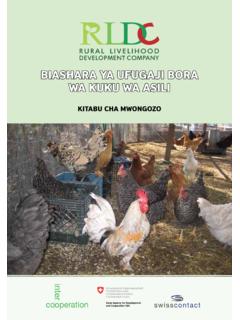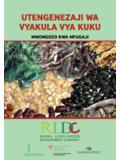Transcription of AAP 37 (1994) 169-179 KAMUSI YA KISWAHILI …
1 AAP 37 (1994) 169-179 KAMUSI YA KISWAHILI sanifu IN TEST: A COMPUTER SYSTEM FOR ANALYZING DICTIONARIES AND FOR RETRIEVING LEXICAL DATA ARVI HORSKAINEN The paper describes a computer system for testing the coherence and adequacy of dictionaries The system suits also well for retiieving lexical material in context from computerized text archives Results are presented from a series of tests made with KAMUSI ya Kiswahlli sanifu (KKS), a monolingual Swahili The test of the intemal coherence of KKS shows that the text itself contains several hundreds of such words, for which there is no entry in the dictionruy. Examples and frequency numbers of the most often occurring words are given The adequacy of KKS was also tested with a corpus of nearly one million words, and it was found out that of words in book texts were not recognized by KKS, and with newspaper texts the amount was The higher number in newspaper texts is partly due to numerous names occurring in news articles Some statistical results are given on frequencies of wordforms not recognized by KKS The tests shows that although KKS covers the modern vocabulary quite well.
2 There are several ru eas where the dictionary should be improved The internal coherence is far from satisfactory, and there are more than a thousand such rather common words in prose text which rue not included into KKS The system described in this article is au effective tool for ,,., detecting problems and for retrieving lexical data in context for missing words 1. Introduction Dictionary compilers have nowadays available a number of tools, which are of great help in searching for data and in arranging the material in a systematic way Various kinds of computer- based storing systems have been devised for making the management of information quick, comprehensive and rtliable Less common are, however, devices for testing the intemal coherence of dictionaries and their capability of covering certain types of texts In the following I shall describe a data searching system, which enables the automatic search of such lexical items in a running text.
3 Which ar e not included in a given dictionary Such a system is useful when there already exists a dictionary, but there is a need to test its adequacy It is also helpful when there is a need to update the existing dictionary, because it enables one to create an ordered database, where words not included in the dictionary appear in their natural contexts. Such a data searching system will in fact replace the traditional databases compiled manually and written on cards I I Still a few years ago Tumbo-Massabo (1989) doubted the feasibility of computerized data banks in developing countlies, due to the unavailability of suitable technology.
4 There is no need to mamtam such 170 ARVI HURSKAINEN The following description is based on tests made with KAMUSI ya KISWAHILI sanifu (hence KKS), the monolingual Swahili dictionaly, prepared by the Institute of KISWAHILI Resealch, University of Dal-es-Salaam. It was first published in 1981, and although it is a useful dictionaly in many respects, it has weaknesses, which should be coiiected in future editions The requirements and problems of monolingual dictionaries in general, and of KKS in particulal, have been discussed elsewhere (KhaJnisi 1987; Chuwa 1987) I am not going to algue here on the structure of the dictionaly itself, because there al'e more than one good way to compile a useful dictionary Rather I shall pinpoint the obvious inadequacies, which the first edition of this dictionary contains Since KKS contains only single words as entries and does not pay attention to their etymology, I shall treat KKS strictly on the basis ofthis choice of the compilers.
5 There would be an urgent need of other types of information also (Calzolali and Bindi 1990), which could be retrieved from a corpus with the tools available, but this has to be left to another context The first requirement of a monolingual dictionaly is that it should have those words as entries which ale used in explaining the meanings of the words given as headwords, and that under each headword sufficient information is given concerning the forms which the headword takes. The computer system under discussion is able to detect such inadequacies, and below, after having described the structure of the system, I shall present test material of two kinds: (1) the written text of KKS will be analyzed and the discrepancies in it detected, and (2) selected modem Swahili prose texts will be filtered to show how well the dictionaly covers the tenninology of different kinds of texts, and how these words can be retrieved in context into a lexical databank for fhrther use 2 The system is composed of the following set of programs, which are run consecutively.
6 1 Normalize the input text, a fiction book, newspaper text etc so that upper case letters are converted to lower case, preserving the infmmation of a capital letter where the word is always initiated with a capital letter; place a blanc alound a word where preceded or followed by a diacritic or punctuation mark, etc. This can be accomplished by a rewriting program, e g a Beta program 3 2 Make a list of all wordforms in a text, and delete all additional occurrences of the same wordform 3 Filter out such wordforms, which are not included into the dictionaly concerned This phase requires the use of a morphological palser, which recognizes the wordforms of the dictionary only See a mme detailed description below doubts any more.
7 Although computers will probably never completely replace the traditional manual work in compiling dictionaries 2 Part of the material from modern texts was retrieved by my students in 1992 when practicing the use and production of retrieving programs I express my gratitude to them for their share in preparing this paper 3 Beta is a programming language, which rewrites text according to user-made rules based on context restrictions and state mechanism. It was first written by Benny Brodda from the University of Stockholm It has been further developed by him and Fred Karlsson and Kimmo Koskemtienti from the University of Helsinki, by using such programnting languages as Fortran, Pascal, InterLisp, MuLisp, and C-language See Brodda 1990 KAMUSJ YA KJSWAHILI sanifu IN TEST 171 4.
8 Find the resulting wordforms in context fi:nm the text used for filtering, and possibly sort them according to the keyword Retrieving can be carried out e .. g with a Beta program, or any other suitable retrieving program For a language with a minimal amount of morphological variation, such as English, a wordform retrieving system could perhaps be built on the basis of a computerized lexicon with a straightforward list of lexical entries. For highly inflecting languages such as Swahili this is not possible The accurate recognition system requires a powerful morphological parser, which builds up words by combining morphemes according to defined rules.
9 In the system described here I have used SW ATWOL, which has been described elsewhere in detail (Hurskainen 1992).. SWATWOL is a morphophonological parser, which uses a language-independent parsing module TWOL (Koskenniemi 1983), and takes a rule file and a dictionary, as well as a text file, as input, and processes the text in a number of modes. The rule file consists of a set of mmphophonological two-level rules, which define the deviant surface fmms of characters in certain phonological environments It is possible to define the environment for rule application accurately by referring to left and light contexts on lexical and surface levels.
10 This rule facility simplifies the structure of the lexicon a great deal and speeds up processing For this specific purpose I have prepared such a version of the lexicon, which recognizes and accepts only those wordfmms, for which there is a lexical entry in KKS, while all other strings of characters are considered unacceptable When mn in a filtering mode, SW A TWOL produces a list ofthose discarded wordforms 2. The internal test of KKS The first task was to test the whole text of KKS and find out its intemal inconsistencies and obvious weaknesses After having run the program with the full text ofKKS we can make the observation that there are discrepancies in all parts of speech, nouns, however, dominating The most fi.






